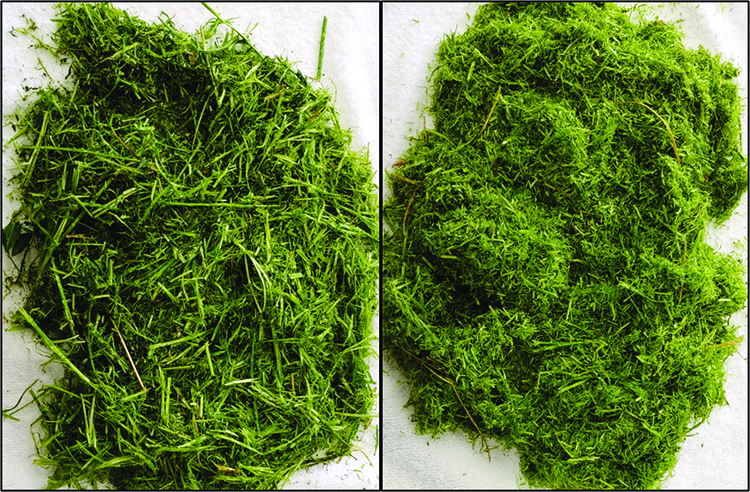Hay & Forage Grower is featuring results of research projects funded through the Alfalfa Checkoff, officially named the U.S. Alfalfa Farmer Research Initiative, administered by National Alfalfa & Forage Alliance (NAFA). The checkoff program facilitates farmer-funded research.

“Nutritionists have told us that fiber digestion is the next frontier in dairy nutrition. If that’s the case, we think we might have something that might help; we can mechanically manipulate alfalfa and improve its fiber digestion,” said Kevin Shinners, University of Wisconsin (UW) agricultural engineer.
Shinners and his colleagues received Alfalfa Checkoff funding to test whether extreme mechanical processing could break down alfalfa plant cells and enhance plant surface area so cows could more readily digest fiber.
Two identical diets consisting of 30% alfalfa haylage, 30% corn silage, and 40% concentrates were fed to 36 lactating dairy cows during a six-week period. The only difference between diets? One was conventionally chopped at a 10 millimeter (mm) theoretical-length-of-cut (TLOC), and the other was conventionally chopped at a 22 mm TLOC, then mechanically processed.
The mechanical processing was done on a modified screenless hammermill that provided processing by impact and shredding. Prior research has shown the combination of impact processing and shredding provided the desired physical results to the alfalfa. The crop was processed through the altered equipment to obtain a processing level that previous research had shown would likely boost fiber digestion.
This initial research’s main goal was to determine if mechanical processing could enhance alfalfa’s feed value, Shinners said. It will likely take time and additional development work before it reaches commercialization, he added. Many questions, including how and when mechanical processing should be done, still need answers. The agricultural engineer envisions processing could be incorporated on the forage harvester during harvest or as the crop is removed from storage and prior to mixing in the TMR.
“We need to find the best mechanical approach to achieve the desired processing level while requiring the least amount of energy,” Shinners said. “This process is going to take significant energy; we can’t break that stem down and fiberize it without putting substantial energy to it. But our initial economic analysis indicates that the benefit we get will more than pay for the extra fuel and power that we believe this is going to take. Hopefully, this will make alfalfa a more competitive feed.”
Shows promise
The feeding trial showed the mechanical processing (MP) diet was more efficient than the conventional (CON) diet. Cows fed the MP diet consumed less feed than those on the CON diet, with a dry matter intake (DMI) of 60 (MP) compared to 62 (CON) pounds per day. Milk yield was nearly the same (103 [MP] compared to 102 [CON] pounds per day), but milkfat percentage was greater for cows on the MP diet as compared to those on the CON diet (3.94% compared to 3.81% fat). Fat-corrected milk (FCM) was also greater for cows fed the MP crop (102 compared to 99 pounds per day), making feed conversion efficiency (FCM/DMI) greater for MP-diet cows than for CON-diet cows (1.69 compared to 1.60).
Future research, said Shinners, may include looking at different crop maturities. “We think we could get a better response if we go with a crop that’s a little more mature than the crop harvested for the feeding trial. What would this process look like when we harvest at a greater maturity or at different moisture contents? Or, what if we set this material not at 30% of the cow’s ration, but at 40% or more?” he asked rhetorically.
“The NAFA funding was excellent seed money and gives us the opportunity to try to sell the USDA on our research. Hopefully, the USDA will invest funding and move this forward,” he said.
Shinners credits David Pintens, an agricultural engineering graduate student, for his outstanding work on the project, despite limitations caused by the pandemic. Others involved in the research included UW agricultural engineers Matthew Digman and Joshua Friede, as well as Kenneth Kalscheur, U.S. Dairy Forage Research Center animal scientist. To view the project final report, visit alfalfa.org.

Project results
1. An impact-shredding processor was developed that produced a processing level index of 74% compared to only 38% for the control chopped material.
2. More than 35 tons of wilted alfalfa were processed and successfully conserved for the lactation feeding trial.
3. Dairy cows fed a diet of processed alfalfa produced 3.1 pounds per day greater fat-corrected milk while consuming less dry matter, improving feed efficiency.
4. Income over feed costs was greater for the extreme mechanical processing diet even though the cost to harvest alfalfa haylage was 1.25 to 1.40 times greater than that for conventionally harvested material.
This article appeared in the Aug/Sept 2021 issue of Hay & Forage Grower on pages 12 and 13.
Not a subscriber? Click to get the print magazine.

